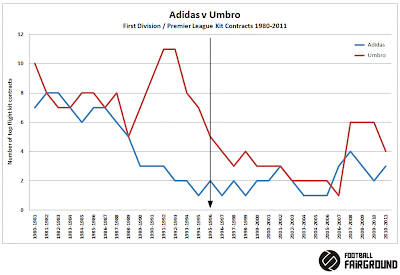The season before, it was only Roy Evans’ Liverpool side that were wearing apparel by the German sportswear giants, but Newcastle United signed on the dotted line and ended up with a now familiar strip that came complete with a ‘grandad collar’ shirt. A year later, Alan Shearer also signed on the dotted line and wore the shirt in front of thousands of delirious fans, but even that adulation wouldn’t be enough to raise the dwindling appeal of Adidas kits among Premier League teams.
Umbro were hanging on to five top team contracts but their share would also drop further over the next few seasons. At least they were providing the kit for Chelsea and Man United – two giants of the English game then and now – but even they were having to fight off the attentions of a new array of companies. Strangely enough, some of them had long and proud histories but were only now appearing in the Premier League spotlight.
Reebok were one such company. Starting life as the Bolton-based sports shoe company JW Foster and Sons in 1895, they changed their name in 1960 and went on to become Bolton Wanderers’ kit supplier from the 1993-94 season. They’ve been Bolton’s outfitters ever since and back in the latter part of the 1990’s were adding the likes of Liverpool and Aston Villa to their Premier League portfolio.
Pony were an American brand who were also better known for making sports footwear. They made a splash in the 1990’s football scene by making kits for several teams, most notably Tottenham, West Ham and Southampton. Their 1993-95 range for the latter pairing raised a few eyebrows by virtue of a large chevron pointing downwards on the shirts – a point used to indicate their direction of travel in the Premier League table by rivals up and down the country.
Bringing up the rear were Puma, the company formed when brothers Adolf and Rudolf Dassler went their separate business ways in the late 1940’s. While his brother forged a new sportswear identity under the Adidas banner, Rudolf formed Puma and the rest, as they say, is history. Of particular note here, Puma were the makers of football strips for Derby, Leeds and Sheffield Wednesday and were very nicely styled indeed.
Le Coq Sportif were still very much in business, just as they had been in 1980/81. When Leicester City gave up on using own brand Fox Leisure, LQS took over the reins during the last days at Filbert Street and also provided the kit for Man City and Charlton Athletic too.
Sadly the death knell finally rang for Asics when Bradford City were relegated in 2000/01. It was the last time the Italian company’s logo was seen on a Premier League kit, but their place in the market would be filled by Kappa who hooked up initially with Blackburn Rovers and Tottenham thereafter. An acquired taste where kit design's concerned, you either love or hate that unmissable logo featuring a naked couple sitting back to back. Perhaps it's that which has prevented more clubs from signing up Kappa for their own kit contracts.
The 2004/05 season was a significant one in that we saw the highest number of different kit manufacturers used by Premier League teams. There were 14 in all, namely: Adidas, Umbro, Nike, Puma, Reebok, Errea, Hummel, Diadora, Kappa, Lonsdale, Joma, Saints, Xara and Pompey Sport.
In 2006/07, Adidas were starting to bounce back and even managed to gain more top flight kit contracts than Umbro for the first time since the 1982/83 season. Along with their long-running association with Newcastle United that had begun eleven seasons earlier, Adidas also lured Chelsea away from Umbro and persuaded Liverpool to end their run with Reebok.
Yet for all that, only one season later, Umbro came back from having only one team on their books (Everton) to having six. This was the time of yet another rebirth for Umbro, a time to reinvent itself with new ideas and new designs. The most noteworthy of them all was the reintroduction of a trailing diamond motif running down the shirt sleeves – a common sight in the late 1970's, rebooted for the late-2000s.
And so in the last few seasons leading up to 2010-11, a new order began to establish itself in the Premier League. Umbro, Adidas and Nike were the main players in the kit supply market with Le Coq Sportif not far behind and a small number of lesser manufacturers further behind still with a token strip here or there. Last year, though, the market expanded once again and the Premier League found itself awash with new names to conjure with – Burrda (from Switzerland), Xtep (the first Chinese kit manufacturer in the top flight), Macron (from Italy) plus Mi Fit and Carbrini from England.



No comments :
Post a Comment